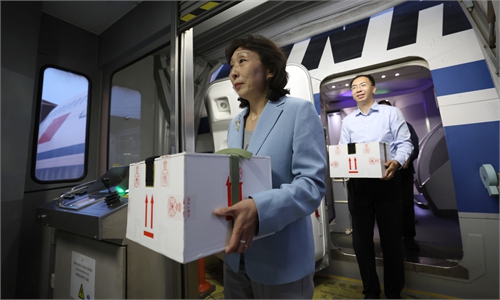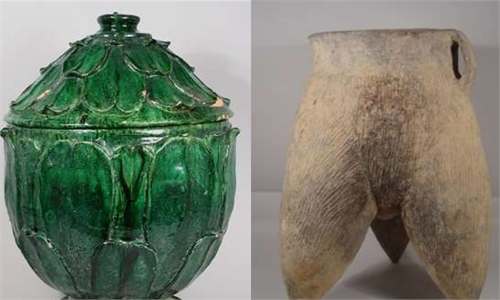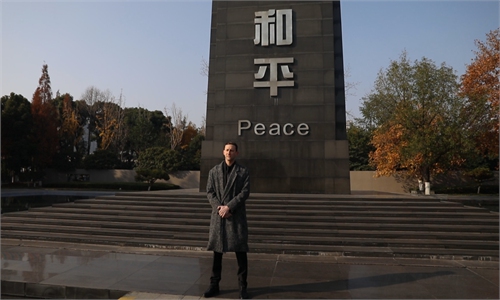ARTS / CULTURE & LEISURE
New relics offer more evidence of Japanese invasion of China
Findings serve as ‘silent textbooks’ of history

An emblem commemorating the 80th anniversary of the victory in the Chinese People's War of Resistance Against Japanese Aggression and the World Anti-Fascist War Photo: Xinhua
A number of sites related to the Chinese People's War of Resistance Against Japanese Aggression (1931-45) and the history of Chinese revolution were newly discovered recently in several provinces during the ongoing fourth national cultural relics survey.
These findings offer new materials for the study of World War II history and serve as powerful physical evidence of Japanese aggression in China.
In Tai'an, East China's Shandong Province, Xintai City organized a specialized investigation team to conduct a field survey of the Xintai section of the Cilai Railway. Over 14 days, the survey team covered six towns and newly discovered 24 railway structures dating back to the period of Japanese aggression in China, Liu Tao, head of the Xintai City cultural relics survey team, shared with the Global Times on Tuesday.
Facing challenges such as the age of the relics and the lack of historical records related to the Xintai section of the Cilai Railway, the cultural relics survey team coordinated with railway authorities and interviewed retired railway employees as well as local villagers along the railway. They also employed advanced surveying and photography equipment to collect precise data on the various types of heritage sites along the railway, according to Liu.
During the investigation, team members discovered that Cuyang Station, built in 1940, marked the starting point of the Xintai section of the Cilai Railway. Existing structures at the site include nine residential buildings for railway workers' families, one waiting room, one coal platform, and one hexagonal pavilion. These buildings were built in a Japanese architectural style, characterized by brick-wood structures, double-pitched red-tile roofs, and exterior walls coated with yellow mixed mortar.
"The Cilai Railway relics offer valuable physical evidence for studying the history of Japanese aggression in China and modern industrial architecture. These relics serve as silent textbooks, reminding future generations to learn from history," said Liu.
"We found some roof tiles marked with the name 'Nanjing Lianyi Tile and Brick Factory,' which reveals part of the economic plundering network established by the Japanese forces."
The year 2025 marks the 80th anniversary of victory in the Chinese People's War of Resistance Against Japanese Aggression and the World Anti-Fascist War.
In June, three additional sites of historical significance were discovered in Heihe, Northeast China's Heilongjiang Province, bringing the total number of wartime or war-related sites newly identified since the launch of the national cultural relics survey to 40.
Jiang Yufeng, deputy director of the Heihe Cultural Heritage Protection Center, told the Global Times on Tuesday that the 40 sites include 12 locations linked to the Northeast Anti-Japanese United Army (NAJUA), and one Soviet Red Army Martyrs' memorial tower. Jiang noted that the three sites add to the 27 sites categorized as evidence of Japan's wartime atrocities.
"These three newly discovered sites are mainly bunkers, shelters, and fortifications, similar to many military outposts found along the Heilongjiang River in Heihe. They all serve as concrete evidence of Japan's intentions during its invasion of China," Jiang said.
He mentioned the discovery of the former Japanese military airfield complex in Handaqi, which consists of three relatively independent airfields, each preserving aircraft hangars, fuel depots, and well-preserved circular taxiways and runways.
These 40 sites also include several with particular historical value such as the Nanshan site of the NAJUA in Bei'an, and the Tianjiachuankou ambush site in Wudalianchi, all of which bore witness to Japan's wartime crimes in China and hold significant historical and military research value.
Meanwhile, 592 cultural relics related to the history of the Communist Party of China (CPC) were discovered during the survey in Central China's Hunan Province, according to a report by the China Culture Daily on Tuesday.
Additionally, South China's Guangdong Province has identified over 450 cultural relics related to the history of the CPC, Nanfang Plus reported.



